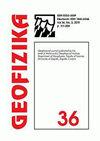Development of a NWP based Integrated Block Level Forecast System (IBL-FS) using statistical post-processing technique for the state Jharkhand (India)
IF 1.1
4区 地球科学
Q4 GEOCHEMISTRY & GEOPHYSICS
引用次数: 0
Abstract
A statistical post-processing forecast system for medium range predictions using the GFS model has been developed for Jharkhand (India) with the aim of improving rainfall and temperature predictions for agricultural applications. The basis of the integrated block level forecast system (IBL-FS) build includes (i) Decaying weighted mean (DWM) bias correction technique, (ii) Value addition and (iii) Inverse distance squared weighted (IDSW) interpolation. In the first step, model bias corrected district level forecast for 24 districts of Jharkhand is generated from the output of numerical GFS model (T1534L64) by applying DWM bias correction technique. In the second step, these bias corrected forecasts are value-added using forecast from various NWP models and synoptic methods. Finally in the third step, the IDSW interpolation method is used to generate the forecast at an unmeasured block from the value-added district level forecast of the surrounding districts. The value-added forecast for 263 blocks for the state Jharkhand is prepared up to medium range time scale (120h). The performance skill of IBL-FS is evaluated for rainfall during monsoon season 2018 and 2019, for minimum temperature during winter season 2019, and for maximum temperature during summer season 2019 using different statistical metrics. The skill of IBL-FS is found to be higher than the direct model forecast (DMFC) by 15% to 43% for minimum temperature, by 18% to 41% for maximum temperature, and by 22% to 30% for rainfall forecast for day1 to day5 forecasts. This study concludes that the integrated approach is more skillful than DMFC for real time forecasts and useful for farming for the blocks of Jharkhand.利用统计后处理技术为贾坎德邦(印度)开发基于NWP的综合区块水平预测系统(IBL-FS)
为贾坎德邦(印度)开发了一个使用GFS模型进行中期预测的统计后处理预测系统,旨在改善农业应用的降雨量和温度预测。综合块级预测系统(IBL-FS)构建的基础包括(i)衰减加权平均值(DWM)偏差校正技术,(ii)加值和(iii)距离平方反比加权(IDSW)插值。第一步,应用DWM偏差校正技术,根据数值GFS模型(T1534L64)的输出,生成贾坎德邦24个地区的模型偏差校正地区级预测。在第二步中,使用各种NWP模型和天气学方法的预测对这些偏差校正的预测进行增值。最后,在第三步中,使用IDSW插值方法从周围地区的增值地区级预测中生成未测量区块的预测。贾坎德邦263个区块的增值预测是在中期时间尺度(120小时)内编制的。IBL-FS的性能技能是针对2018年和2019年季风季节的降雨量、2019年冬季的最低温度和2019年夏季的最高温度使用不同的统计指标进行评估的。IBL-FS的技能比直接模型预测(DMFC)的最低温度高15%至43%,最高温度高18%至41%,第1天至第5天的降雨量预测高22%至30%。这项研究得出的结论是,在实时预测方面,综合方法比DMFC更熟练,对贾坎德邦区块的农业也很有用。
本文章由计算机程序翻译,如有差异,请以英文原文为准。
求助全文
约1分钟内获得全文
求助全文
来源期刊

Geofizika
地学-地球化学与地球物理
CiteScore
1.60
自引率
0.00%
发文量
17
审稿时长
>12 weeks
期刊介绍:
The Geofizika journal succeeds the Papers series (Radovi), which has been published since 1923 at the Geophysical Institute in Zagreb (current the Department of Geophysics, Faculty of Science, University of Zagreb).
Geofizika publishes contributions dealing with physics of the atmosphere, the sea and the Earth''s interior.
 求助内容:
求助内容: 应助结果提醒方式:
应助结果提醒方式:


